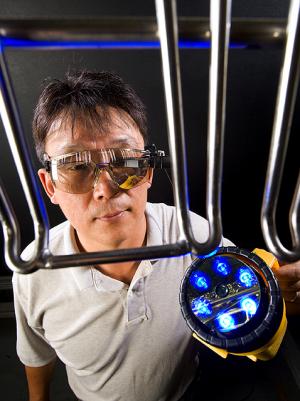Scientists led by Yud-Ren Chen at the ARS Instrumentation and Sensing Laboratory, Beltsville, Md., are designing such portable inspection devices by adapting optical technology used for remote sensing of Earth.
Prototypes include binoculars with lenses that detect fecal matter on meat, produce or processing equipment--as well as diseases or quality defects. A camera/light combination can be helmet-mounted or used in a hand-held device to expose fecal matter as white specks on an eyewear-mounted computer display.

The portable devices are the next stage for a team that recently handed industry a prototype of an on-line imaging system for chicken inspection. Next will be a similar system for inspecting fruits and vegetables.
Team member Stephen Delwiche, working with colleagues at the ARS Grain Marketing and Production Research Center, Manhattan, Kan., has succeeded with high-speed optical inspection of wheat and other grains, detecting protein content as well as mold.
At the ARS Sugarbeet and Bean Research Unit, East Lansing, Mich., Renfu Lu's team uses laser beams to judge taste, firmness and other quality aspects of fresh produce.
Machine vision nicely supports human inspection because its instruments shine light on every single fruit, vegetable, grain kernel, or meat or poultry product that speeds along the processing line. It also gives inspectors an extra pair of eyes for scanning equipment and processing areas for contamination invisible to the naked eye.
ARS is the U.S. Department of Agriculture's chief scientific research agency.
Note: This article has been adapted from a news release issued by USDA/Agricultural Research Service.






Comments